5—
Dedication Frontispieces (Book I)
The Dedication Portrait and Frontispiece of the Prologue in MS A
A comparison of the dedication scene of C with those of A reveals a different approach to illustration. All three, however, belong to the intimate type of dedication portraits, marked by the direct communication of the king with authors or translators, without the intervention of courtiers or officials.[1] The intimate dedication portrait confirms the king's intellectual character and his enjoyment of the company of the writers and translators in his entourage. The close relationship between Charles and Oresme, for example, is documented in the dedication scene of Oresme's translation of Ptolemy's Quadripartitum (Fig. 3), dating from 1361 or 1362.[2]
As the first miniature in the manuscript (Figs. 6 and 6a), the dedication scene of the prologue exemplifies the usual format of the A illustrations. The miniature is tied to the design of the folio both in its width, equal to that of a column, and in its height, equal to sixteen lines of text. Links to the decorative structure of the folio are also strong. Figure 6 receives emphasis by its relationship to the initial E , the outer frame, and the foliate border. The inner frame of Figure 6, a red, white, and blue quadrilobe, is a typical feature of this manuscript and many others of the period. Also standard for the illuminations of this cycle is the simple double outer frame and the gold lozenges that fill out the area between the outer rectangle and the quadrilobe. The rose fleur-de-lis background is used in the first six miniatures of the A cycle. Although it plays a decorative role, it also alludes to the patron's royal status—here explicitly, elsewhere implicitly. Figure 6, moreover, follows the major color scheme of the cycle, based on a red-gold-blue triad. Charles V, wearing a blue mantle trimmed with white fur, stands out against the gold curtain and the rose fleur-de-lis outlined in black. Oresme's costume, a more subdued blue-gray, falls into the same color range. Red accents are found in the baldachin, the book, and the bystander's mantle. Gold is more prominent than usual, used here not only in the curtain but also in the faldstool and crown.
The baldachin and fleur-de-lis motifs of Figure 6, repeated in the dedication scene of Figure 7, are indebted to the famous presentation scene by Jean Bondol representing Charles V and Jean de Vaudetar, the donor of the book, a Bible historiale , dated 1371 (Fig. 8).[3] The style of Figure 7 is also closer to that of the Bondol prototype. The convincing gestures and expressions of the king and translator suggest that this dedication scene, part of the elaborate frontispiece, was executed
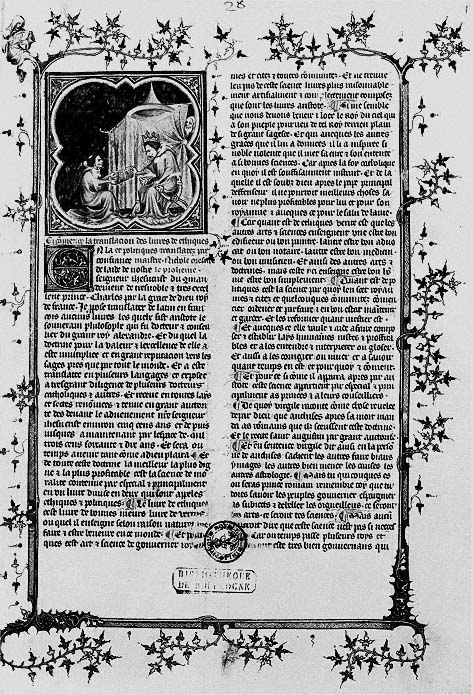
Figure 6
Charles V Receives the Book from Nicole Oresme. Les éthiques d'Aristote, MS A.
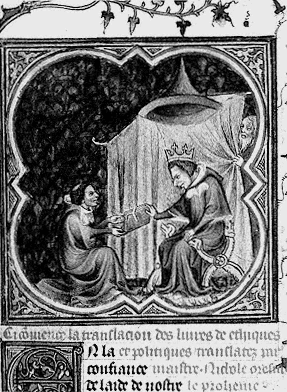
Figure 6A
Detail of Fig. 6.
by the head master of the Jean de Sy shop. The excessively large head and truncated body of Charles V in the prologue dedication (Fig. 6), in contrast, suggest that a member of this atelier was entrusted with this more modest miniature. Whereas the image of the king in Figure 6 is more conventional and his appearance more youthful than in Figure 7, the portraits of Oresme are both individualized. Also similar in both dedications is the gold curtain, suspended from rods and set obliquely to the picture space; its boxlike character defines the royal sphere. Although its abbreviated form permits no conclusions, it suggests an enclosed chamber or other private space as the locale of the presentation.[4]
The documentary function of Figure 6 is related to its position at the head of the first column of text on folio 1 of the manuscript. The illustration identifies those who set in motion the translation contained in the volume presented. Kneeling at the left is the translator, whose name appears in the three-line rubric written under the miniature: "Ci commence la translacion des Livres de Ethiques et Politiques translatéz par maistre Nichole Oresme" (Here begins the translation of the books
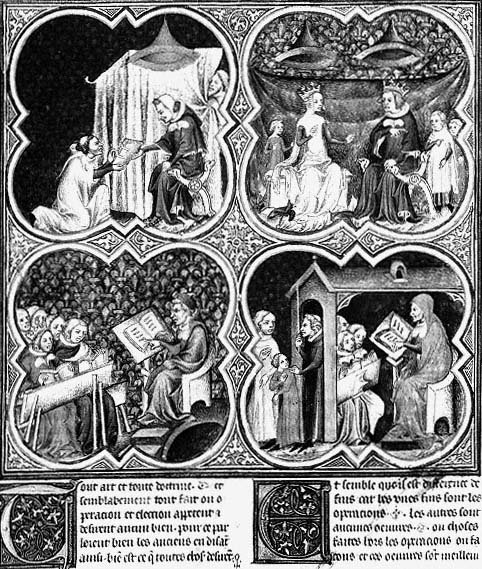
Figure 7
Above, from left: Charles V Receives the Translation from Nicole Oresme, Charles V and
His Family; below, from left: A King and His Counsellors Attend a Lecture, The Expulsion
of a Youth from a Lecture. Les éthiques d'Aristote, MS A.
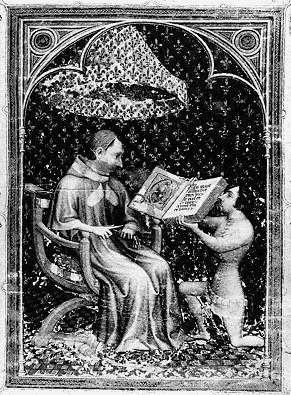
Figure 8
Jean Bondol, Charles V Receives the Book from
Jean de Vaudetar. Bible historiale.
of the Ethics and Politics translated by Master Nicole Oresme).[5] The next sentence, highlighted by an elaborate six-line foliated and dentellated initial E names the patron:
En la confiance de l'aide de Nostre Seigneur Jhesu Crist, du commandement de tres noble et tres excellent prince Charles, par la grace de Dieu roy de France, je propose translater de latin en françois aucuns livres lesquelx fist Aristote le souverain philosophe, qui fu docteur et conseillier du grant roy Alexandre.
(Confident of the help of Our Lord Jesus Christ, at the command of the most noble and most excellent Prince Charles, by the grace of God, king of France, I propose to translate from Latin into French some books written by Aristotle, the supreme philosopher, who was the teacher and counsellor of the great king Alexander.)[6]
The crown and faldstool associated with the king seated on the right establish the royal identity of Charles V. Two other features of this introductory sentence are worthy of comment. First, Oresme gives himself an important role in the enterprise by using the phrase "je propose." Then he sets up a discreet but flattering parallel between Charles V and himself, the contemporary equivalents of Alexander and Aristotle, in their roles as ruler and counsellor, pupil and teacher. Following a medieval custom, the translator's appropriation of Aristotle's identity as author carries out this theme on a visual level.
Oresme also points to the value of the text, recognized by "pluseurs docteurs catholiques et autres" (many Catholic doctors [of the Church] and other authorities), and its universal reputation "en toutes lays et sectes" (in all religions and sects), from the time of its composition to the present day.[7] The translator does not neglect to pay tribute to the wisdom and intellectual interests of his patron.[8] Charles V's love of study and learning not only promotes the common good but unites the two men. These mutual interests and long personal ties are commemorated in Figure 6a, particularly in the direct glances and friendly expressions of both parties. While Oresme's kneeling posture expresses his respect, his knee and hands penetrate the space occupied by the king. Moreover, the left side of the book held by Oresme is supported on the right by Charles V. The volume's red color, highlighted against the gold curtain, emphasizes the book as both document and symbol of the concrete tie that exists because of their mutual efforts. Finally, the gesture of Oresme's left hand indicates the act of handing the book over to the king, a moment of gratification to both translator and patron.
The Dedication Frontispiece:
The Upper Register
The dedication scene of A (Fig. 7) is not a self-contained unit but one of four quadrilobes that make up a miniature occupying half the folio. The exceptional size of the illustration, the second largest of the manuscript, indicates the importance of the folio. The double set of dentellated and foliated initials that introduce the six lines of text below the miniature gives a decorative emphasis to the folio. The contrasting red and blue geometric backgrounds accentuate the symmetrical composition of the miniature, enhanced by the color scheme of the inner frames. The use of gold for the lozenges on all edges of the quadrilobes and in the curtain on the upper left completes the sumptuous effect of the overall design. In a minor key, the pinks, blues, reds, and golds of the exterior frames, initials, and leaves weave a decorative unity with the major color chords of the miniature.
The quadrilobes are the same size as that of Figure 6 and are laid out symmetrically, with the central squared tip of the lower one reaching up to touch the corresponding part of the upper one. The left and right edges of each quadrilobe line up with the text block and are equal to the width of each of the two text columns; the central gold lozenges span the space between the columns.[9]
An interpretation of the four miniatures can begin by analyzing this first scene. Placed on the upper left, it begins a sequence that proceeds from left to right,
beginning at the top. In one sense, the miniature inaugurates the book's emphasis on the theme of education, beginning with Charles V's instruction by Oresme in general and extending to the specific knowledge contained in the Ethics and Politics . The changes in iconography from the prologue dedication (Fig. 6) may also indicate a temporal sequence. The king's homely coif lends an informal quality to the less official character of Figure 7. The king's smile conveys an intense, personal relationship between patron and translator. Charles V glances at Oresme, whose head now overlaps the royal sphere. Moreover, the translator's movement toward the king is reinforced by the gesture of Oresme's left hand, which seems to loosen the book's lower clasp. The suggestion of opening the book indicates a further step in the temporal sequence, either in the narrow sense of proceeding with the next step in the presentation ceremony or with a wider suggestion of disclosing the reasons the translations were commissioned and the appropriate audiences for them. In Figure 7 the illuminator's style—its fluent rendering of movement and naturalistic corporeality—helps to intensify the close relationship between Oresme and Charles V and their expressions of pleasure in the completion of the jointly undertaken project.
The second scene, on the upper right, emphasizes the king's role in making the teachings of the Ethics available to his family by commissioning the translation. Although Charles V's portrait is more generalized than in the dedication scene, the facial features suggest that this scene is meant to refer to him and his family. By 1372, the date of the colophon of A , Charles V and Queen Jeanne de Bourbon had three children.[10] Precedents for a king giving instructions about the education of his family come from various Mirror of Princes works. This theme is standard in French translations with royal connections of Giles of Rome's De regimine principum . Repeating Aristotle's emphasis on the importance of educating the young, a French translation of Giles's text, Li livres du gouvernement des rois executed for King Philip IV in 1296 by Henry of Gauchi, stresses the responsibility of the ruler for his children's education. The royal offspring must possess greater goodness, learning, and virtues than those of their subjects.[11] A lavishly illustrated mid-fourteenth-century text closely related to Giles's work, the Avis au roys (New York, The Pierpont Morgan Library M. 456) makes a similar point in the rubrics of a section devoted to the education of princes.[12] Furthermore, the Avis au roys contains two illustrations that represent a king giving instructions on the upbringing of his family.[13] In Charles V's own library, an illustrated manuscript of another Mirror of Princes text, Le gouvernement des rois et des princes , has a frontispiece with a four-quadrilobe structure (Fig. 9). On the upper right, a king and his family are depicted in a fashion similar to that of Figure 7.[14]
Ties between the tradition of French Mirror of Princes texts and the upper right quadrilobe of Figure 7 are noticeable in Oresme's prologue to the Ethics translation and in Book I. Both the Ethics and Politics define the goals of earthly existence and constitute the "science civile" (civic science).[15] Oresme characterizes the Ethics as a book of "bonnes meurs, livre de vertus ouquel il enseigne, selon raison naturel, bien faire et estre beneuré en ce monde" (good moral values, a book of virtues that teaches, according to natural reason, to act justly and be
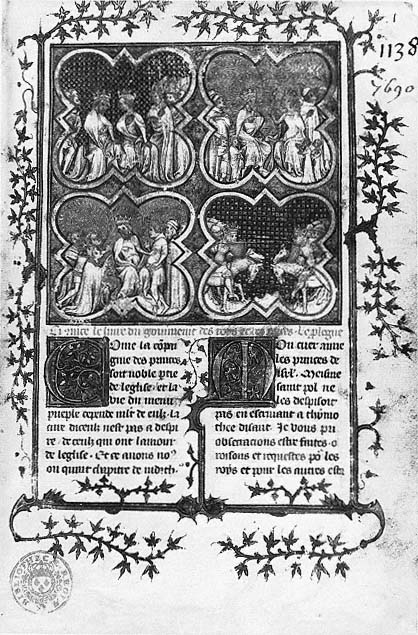
Figure 9
Above, from left: A King and Queen Speak with Prelates, A King and His Family;
below, from left: A King Rendering Justice, A King and Warriors on Horseback.
Le livre du gouvernement des rois et des princes.
blessed in this world).[16] By commissioning French translations of the Ethics and Politics , Charles V is discharging his duties as ruler and as father. The "livre de bonnes meurs" will benefit the royal family and the common good of the realm. Indeed, the analogy between the father-son relationship and that of a king to his subjects is a theme of a gloss in Book VIII of the Ethiques .[17]
In Figure 7 Charles V's commanding gesture toward his son illustrates his authority over his family. Yet the queen who receives his instructions also has a role to play. Crowned and seated below her own baldachin, Jeanne de Bourbon turns toward Charles V in a listening pose, indicated by her upraised arms. French queens were traditionally entrusted with the early education of their children. In an ordinance of 1374 dealing with the succession, Charles V made Jeanne de Bourbon chief guardian of the royal children.[18] Thus, this scene illustrates contemporary historical practice and goes beyond the Aristotelian text and Oresme's translation in which queens do not figure. This extratextual allusion both confirms the origin of this scene in the Mirror of Princes and the personal references of the upper register.
The depiction of the royal family is quite formal, dominated by the gold crowns, gray-green curtain, and twin blue baldachins set against the rose-and-black fleur-de-lis background. Still, the use of gold is restrained, limited to several small areas, such as the crowns, faldstools, and the cloths below the queen's bench and king's chair. Blue is the dominant color, repeated in Charles V's robe and the baldachins, as well as in the underskirt of the queen's dress, with its fur yoke and pale rose folds. Red accents appear at the peripheries in the robes of the princess and her younger brother, whereas the Dauphin's costume, with its two distinctive ermine bands on the right shoulder, echoes the colors worn by his mother. The aggressive folds of the dull gray-green curtain unite the two halves of the composition and establish a planar and spatially ambiguous setting. Frontality is avoided by the turn of the royal couple's bodies and tension is added to the otherwise static scene by their hand gestures. As the upper register moves from translator and patron to the royal family, so an implied narrative suggests temporal movement, from the commission to the practical diffusion of the ideas—based on the Mirror of Princes literature—to be found in the translation.
The Dedication Frontispiece:
The Lower Register
In the lower register, however, personal references give way to a more general, allusive tone. If the top two quadrilobes are related to the Ethics , the bottom pair refers to the Politics . Even more than the upper scenes, the lower ones have a strong narrative content, again related to the important Aristotelian emphasis on education.
On the lower left, a scholar seated on a raised chair is lecturing or commenting on an open book, possibly the present translation. His audience, seated at desks, consists of two full-length figures in the front row, holding open copies of books, and three others, whose heads are visible behind them. A gold crown identifies
the bearded man on the left as a king. The head of the man between the two front figures peers anxiously at the book held by the king's ostensibly younger neighbor. The title of the third chapter of Book I of Oresme's Ethics translation links this miniature to the text: "Ou tiers chapitre du proheme il monstre quelz personnes sont convenables pour oÿr ceste science" (In the third chapter of the prologue he demonstrates what persons are appropriate listeners of this science).[19] As previously noted, Oresme's prologue emphasizes the value of the science of politics to princes and their counsellors.[20] Oresme adds to his invocation of classical authorities the passage of Scripture mentioned earlier: "Audiens sapiens sapientior erit"—"le sage sera plus sage de oÿr ceste science."[21] Thus, the audience that will benefit by knowledge of the texts is precisely the one represented in the lower left miniature: a king and his advisers. This audience is not only reading but listening to an oral explication, perhaps the equivalent of Oresme's commentary on these texts. The miniature also reveals that this is not the usual clerical audience that gathered for school lectures, but lay people, whose intent expressions convey their concentration on understanding the text of the Politics .[22]
In the remaining quadrilobe on the lower register, within a simple structure that, for pictorial reasons, lacks a front wall, another lecture is being given, this time by a hooded master. This teacher is seated on a raised chair with lectern, similar to that of his counterpart on the left. His audience, however, is smaller: two full-length figures are in the front and the head of another appears behind them. The two, who hold open books, listen attentively to the lecturer, who points to the second of three lines of the text. At the same time, a child is being led through the door away from the lecture. His adult companion looks anxiously at a stern, tonsured master holding in his hand a threatening rod. The expulsion of the youth indicates an educational experience unsatisfactory for the youth and possibly disruptive for the class. The text states: "Et pour ce un joenne homme n'est pas convenable audicteur de politiques, car il n'est pas expert des faiz qui aviennent a vie humainne" (And for this reason a young man is not a suitable audience for politics, for he is not experienced in the things that can happen in life).[23] Oresme elaborates in a gloss: "Mais le joenne d'aage ne la puet pas plainnement entendre pour ce que il a peu veü d'experiences et si est plus tempté de desirs corporels" (But those young in years cannot give their full attention to it because they have seen few happenings and in any case are more tempted by bodily desires).[24] According to the text, the adults in the audience profit by the knowledge contained in the text because they are governed by reason. In short, the youth proved to be an inappropriate audience, and his expulsion contrasts an unsuccessful attempt at education with a beneficial adult experience.
This point comes across partly by the repetition in the two lower scenes of the same composition: a single seated figure on the right faced by groups of students on the left. The additional motifs of the school building and the three figures on the left in the right quadrilobe are variations on the theme. Color differentiates the lower two quadrilobes as well: rose fleur-de-lis are on the left, blue ones on the right. Continuing the contrast, scarlet is worn by the king on the left, blue by his companion, whereas blue is worn by the master on the left, and red by his
counterpart. This use of red emphasizes the important figures of the errant child and the lecturer, while paler tones are reserved for the less active ones. The red-and-blue opposition of backgrounds and major figures sets up a structure of verticals and horizontals that relates the quadrilobes of the lower register to those of the upper. The decorative system, particularly the two six-line initials, continues the color harmony.
While the interpretation of left to right and upper to lower sequence seems generally correct, other readings are also possible. For example, the education of Charles V by Oresme on the upper left relates to the ideal audience below. Likewise, the steps taken in the upper right scene to assure the education of Charles V's children show in the scene below the effects of subject and age on a successful learning experience. Indeed, the two scenes of the lower register may present Oresme's attitudes toward education, that is, pictorial comments designed by the commentator and translator of the texts. Such intellectual daring, wit, and irony are characteristic of Oresme and are also a subtle tribute to the presence of these qualities in Charles V—his patron, student, and primary audience.
The Dedication Frontispiece of MS C :
General Features and the Upper Register
Perhaps the subtleties of the nonverbal, visual comments of Figure 7 proved too elusive for the patron and other concerned readers. In any case, the dedication frontispiece of C (Fig. 10 and Pl. 1) underwent substantial revision. Setting the tone for the increased didacticism, substantial inscriptions added to the miniature attempt to clarify the meaning of the scenes, now reduced from four to two. Figure 10 also establishes another precedent followed in the other nine illustrations of the C cycle. Instead of the quadrilobe frames and columnar format of most of the A illustrations, those in C occupy the full width of the text block. Frequently, but not always, they occur at the top of the folio. The C illustrations thus become more prominent, since they function as frontispieces to each book of the text. The less elaborate and expensive character of C resulted in the substitution of grisaille forms for the brilliantly colored figures of A . Yet with added touches of gold and colored washes, these grisaille figures stand out strongly against their colored backgrounds. Highly refined, the elaborate geometric or swirling patterns are executed in peach or blue tones and outlined in gold, black, and other colors. The peach tones of the background of the upper register in Plate 1 contrast sharply with the deep blues of the lower zone. Although the miniatures of C have simple, two-banded frames, they are usually tied to the marginal borders by foliage motifs, which in turn often connect with the large initial below the illustrations. In Figure 10 the dragon drollery of the right margin reinforces the links between the miniature and the decorative structure of the folio.
Whereas the extraordinary inscriptions of the upper register of Figure 10 indicate that the scribe, Raoulet d'Orléans, must have had an important role in executing the miniature, Nicole Oresme undoubtedly chose the texts. Two elaborate and delicately delineated scrolls accompany the scene of the king receiving a
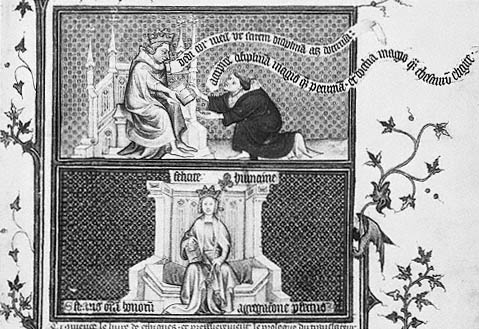
Figure 10
Above: Charles V Receives the Book from Nicole Oresme; below: Félicité humaine. Les
éthiques d'Aristote, MS C.
book from the translator. The book, held by each man and containing the present translation, is the focus of the verbal messages. One scroll unfurls at the level of Charles V's chin; the other curves around Oresme's head. The inscriptions are written in heavy black ink, a departure from the usual brown used elsewhere in the manuscript. Also unusual is the extension of the scrolls beyond the frame of the miniature into the right margin; in fact, the inscription around Oresme touches the very edge of the folio. With the exception of the phrases surrounding the personification in the lower register, the use of Latin for these messages is unique in this translation and signals the exceptional weight and authority associated with words in Latin. Not surprisingly, the inscriptions are taken from familiar scriptural passages. The scroll next to Charles V reads: "Dedi cor meum ut scirem disciplinam atque doctrinam," or "I devoted myself to learning discipline and doctrine."[25] The scroll around Oresme, derived from Proverbs 8:10, advises: "Accipite disciplinam quam pecuniam, et doctrinam magis quam thesaurum eligite," or "Choose learning rather than money and choose instruction more valuable than treasure." Couched in biblical language, the inscriptions invest the secular and pagan texts with religious sanction. Also, the messages on the scrolls make explicit
the theme of education, which in the frontispiece of MS A (Fig. 7) remains more allusive. Furthermore, the elimination of Charles V's family from the dedication scene concentrates attention on the king's motives in educating himself.
As the words spoken by each man separately, the inscriptions also point to the relationship between Charles V and Oresme. The message on the scroll next to the king indicates that by his specific commission of the Aristotle translations he fulfills his obligations as a wise ruler.[26] In doing so, he heeds Oresme's strong admonition, which confirms the translator's position as moral and intellectual adviser to the king. Indeed, the much shorter inscription and humbler tone of Charles V's declaration contrasts with the lengthy quotation Oresme selected for himself. Also conveying the translator's standing is his choice of a quotation, used here to address the king, that habitually employs the imperative mood of the verb.
The composition likewise emphasizes the prominent role Oresme assumes by the authority of the inscriptions. While the dedication scene is another example of the intimate type, certain aspects of the miniature show a greater formality than the analogous illustrations of A (Figs. 6 and 7). For example, in Figure 10 the king's frail form is enclosed in an intricate thronelike structure.[27] In addition, the king looks down at the book as much as he regards the translator. Depicted in profile, Charles V does not, as in Figures 6 and 7, directly establish eye contact with Oresme. Also missing are the warm smiles of both parties. Despite his distance from the king, Oresme, whose head is represented in a fuller, three-quarter view, tilts his head upward to glance at the king. Although only the translator's hand advances into Charles V's sphere, his kneeling form dominates the picture space. Just as his portrait is more amply and naturalistically rendered than the conventional, doll-like image of the king, Oresme appears as the more solidly represented figure. And while Charles V is confined within the throne, Oresme's bulky form, placed on a separate stagelike strip, spreads out laterally. The deep blue of his robe overwhelms the gentle grisaille tones of his patron's figure. Oresme's is the only figure in the C cycle whose costume is painted.[28] Even the additions to the translator's prologue of C of his name and title, "Je Nicole Oresme doyen de l'eglise nostre dame de Rouen" (I, Nicole Oresme, dean of the church [cathedral] of Our Lady of Rouen), suggest the expansion of Oresme's role in the translation enterprise. In A no title is included, and his name, "maistre Nichole Oresme," appears in the opening rubrics but not in the prologue text. The presentation miniature of C , dated 1376, shows the evolution in visual form of Oresme's relationship with the king. From the early, intimate presentation scene accompanying his first French translation for his patron, Ptolemy's Quadripartitum (Fig. 3), to the dedication portrait of C , Oresme assigns himself an increasingly dominant role.
The Dedication Frontispiece:
The Lower Register
A second seated, crowned form who holds a book occupies the lower register of Figure 10. Unlike the parallel figure of Charles V, the representation is not a historical personality but a personification of the opposite sex. Her crown and
scepter mark her as a queen, and her domination of the whole picture signifies her importance in the frontispiece.[29] The French inscription identifies her as Félicité humaine, or Human Happiness. As a major subject of Book I, the phrase Félicité humaine occurs frequently in the chapter headings that follow the illustration, justifying the reason for her prominence. Figure 10 is placed on folio 5, at the head of the prologue and apologia of the translator. As a rule, chapter headings precede the illustration. In this case, however, the function of the miniature as a frontispiece and the relationship of the upper register to the prologue probably account for the change in order. Furthermore, an introductory sentence of Book I contains these words: "Ou premier livre, il met son proheme et traicte de felicité humainne en general" (In the first book he sets forth his prologue and discusses human happiness in general).[30] Thus, instead of the two narrative scenes in the lower register of A (Fig. 7) that deal only indirectly with education and the proper audiences for the translations, Figure 10 clearly identifies the principal subject of both Book I and the entire text.
Félicité humaine is further defined by Latin inscriptions that flank the base of her throne. On the left, there appear the words "Stans omnium bonorum" (abode of the highest good); on the right, "agregatione perfectus" (union of all that is good). The mixture of languages in the inscriptions is puzzling. Why was Latin used for the characterization, but not for the identification, of Félicité humaine, which derives from the text of the translation? As with the biblical verses of the upper register, this recourse to extratextual sources confers on the image dignity and authority equal to those associated with the historical personalities of the upper register. Oresme may also have attempted to enrich the spiritual attributes of Félicité humaine verbally since her appearance does not differentiate her from other seated and crowned figures. Unlike the inscriptions of the upper register, those of the lower zone are not harmoniously integrated with the composition. The rectangular band at the top is placed asymmetrically in relation to the throne, and the spacing of the two words is awkwardly interrupted by the scepter.[31] In other words, the designer of the miniature failed to integrate the prominent inscriptions with the figural element.
The high social standing of Félicité humaine is conveyed by her frontal pose, which is associated with a ruler seated in majesty. The motionless effect thus created suggests an ideal realm, contrasting with the historical and personal space inhabited by Oresme and Charles V, who are depicted in three-quarter and profile views respectively.[32] The gold of her cushion, book, belt, scepter, and crown further signal her sovereignty. These attributes are appropriate to Human Happiness, who in Aristotle's definition personifies the good toward which all knowledge and human activity aim. In the C illustrations, Félicité humaine is the only personification awarded a crown. The book she holds may relate to the text passage that states, happiness is achieved by "discipline et par estude" (discipline and study).[33] Her costume recalls Oresme's comparison of Félicité to a well-dressed person ("bien vestue de robes").[34]
The royal attributes of this figure may also cause the reader to associate her with the king seated almost directly above her. Félicité holds a book that is almost
identical with the one held by Charles V. Félicité's frontal pose and outward-looking gaze emphasize the book's ability to open the way to Human Happiness. Could it not be inferred that the "doctrina et disciplina" revered by the king could bring about Human Happiness? Oresme writes in the prologue of the beneficial effects on the common good brought about by a love of learning, the most desirable pursuit (after religion) of princes and their advisers. The love of knowledge avowed in the upper register by Charles V is further linked to Félicité humaine by two emblems of French royalty: the fleur-de-lis of her crown and her scepter. Human Happiness, then, is a result of Charles V's wisdom in pursuing knowledge that benefits his kingdom. The present translation into French, containing the ethical values and political ideals necessary for good government, is an example of such conduct. Félicité humaine is thus the spiritual consort of Charles V. Several devices link the historical ruler of the upper zone to the ideal sovereign of the lower: parallel placement of the figures, display of the book, and repetition of royal symbols. Even the use of French to identify Human Happiness reinforces the association. The timeless excellence symbolized by Félicité humaine connects queenship with lofty spiritual ideals, a relationship that acknowledges feminine powers in a manner foreign to the text. This first depiction in the sequence of illustrations of positive abstract concepts by female personifications continues, however, an iconographic pictorial tradition inherited from classical antiquity.
Because of the different functions of the manuscripts in the king's library, the dedication frontispieces of A and C reflect different approaches to text-image relationships. The substantial reworking of the program of Figure 10 represents part of an editorial and visual redefinition. Without substantial changes in the text, the alteration from the allusive, nonverbal mode of Figure 7 to the didacticism of Figure 10 suggests a response to a critique of the former, possibly initiated by Charles V himself. Ambiguities in the meaning of both frontispieces, despite the attention lavished upon them by patron, translator, scribe, and miniaturists, hint at the complex processes involved in the visual representation of Oresme's Ethics translation.